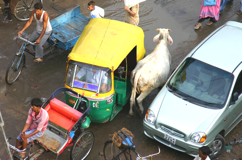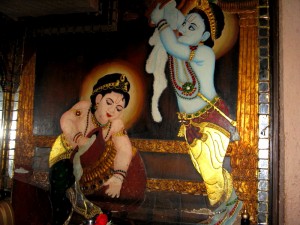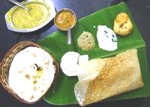Food Muse: A WRAP FOR A RAJ — Scenes From The Life Of The Dosa
In India, dosas are cooked on a griddle in the street, as well as in restaurants and homes. As street food goes, the dosa gets high marks. It’s not junk, and it tastes great. The Dosa Factory in Central Square, subtitled “Indian Street Food,” is a hole-in-the-wall–not for an evening of food and talk. But that’s not what street food is. It’s a quick fix, and for these purposes, it’s about as good as it gets.
By Sally Levitt Steinberg
India is many-colored, demonstrative, multi-voiced, loud, prayerful, sari-ed. India is a place that gives rise to digression. Everything competes to grab your attention, even when people are not trying to. The hawkers, the beggars around shrines, the chants in the temples, the women in their gorgeous saris in every color, coloring the alleys and roadsides and villages and countryside, coloring the dun-colored city streets that would be grey if you imagine the women in cheap polyester. How boring the streets would look. But this is India. The women beautify it with their décor.
Here is a frieze of some of the girls—look how they decorate! They are elders, some toothless, with jangling ankle bracelets and bracelets up the arms, and colors, colors, against the corrugated tin wall of the shop, barefoot or with cheap flip flops, and cows all around. Old or young, fat or thin, pretty or ugly, the women in their colors look beautiful and lend beauty to the land. I met my rickshaw driver’s mother in the night on a deserted street with no light–she’s in her sixties, cleans houses–in green and silver sari, grey hair pulled back in a bun and buck teeth, many wrinkles, beautiful.
This is a society as profuse as its unimaginable traffic. To get anywhere, you pass cows and working elephants on the biggest multilane roads, and smaller ones. Lanes? What’s that? No one respects the rules, only their own territorial imperatives, especially the rickshaws, which define the word “dodgy”, as your heart is in your throat because you are dodging huge trucks and cars racing at no-speed-limit speeds. Chaos prevails, cows and rickshaws weave in and out in mutual tolerance.
The population is not only a growth gone mad and uncontrollable, but its heterogeneous composition is not to be teased apart and understood by outsiders. Everything in it is so complex that it escapes the grasp, and the more you know the more you know that you don’t. Take the food, an impenetrable matrix–so numerous are its ingredients, so complicated its compositions, so diverse its uses, its traditions and locales, its rituals, communal and domestic and religious. One example suffices to suggest the complexity: spices must be ground and cooked in a specific order. The carnivalesque profusion of dishes in every color and shape and texture on the table is stunning.
Dinner
It is night in Delhi, India, in Hauz Khas, which has been called the Soho of Delhi, if you re-imagine right-angled buildings as tumbled ones. Inside the tumble are aspiring boutiques, funky clothing shops, and an arty bookstore. Hauz Khas belonged to Muslim royalty in medieval times, and it used to be a rural village with buffaloes. Now, when you walk into its alleys, it feels ancient and remote, and also part of the new spirit of adventure in India. The bars and restaurants could be in a Western city’s trendy neighborhood. But the feeling is timeless, and Indian.
Hauz means tank and khas means royal–the tank, or reservoir, was kept as part of the royal landscape, and birds migrated there. The traditional features of Hauz Khas persist as backdrop, 14th century sultans’ tombs, a madrasa and the reservoir, in a parkland preserve. A green space at one end is studded with the ancient tombs. In the dark you see looming hemispheres, otherworldly, heavy and sepulchral, shadows you can only guess at. It’s not for tourists, no sound and light show, no lights at all.
Hauz Khas is entered through an opening off a trafficky main road, through cars parked helter skelter. You wouldn’t know it was there unless you knew. But people do know and you have to reserve its restaurants, just like all Delhi restaurants, because no matter how remote and unfindable in this city of former villages alternating with green patches and strung together, they are “fully booked, sorry.”
We wander the crooked bumpy paths of Hauz Khas, which appeared in an article in the New York Times, although it’s hard to imagine. It seems far away from the rattling pages of our breakfast companion. We are heading toward a restaurant known for its Southern Indian fare, Naivedyam, which means offering. It’s a favorite of author Arundhati Roy, with its statue of a Nandi bull from Hindu religion ablaze with votive lanterns made of ghee guarding the entry, bestowing an air of mystery and beneficence, and an aura of flickering light.
The bull is part of a ritual, with Sanskrit chants and ringing bells, the bull on the altar anointed with vermilion paste, which is considered auspicious, and sprinkled with flowers and surrounded with incense. There are banana trees outside. Inside, there’s lots of red and gold, gold walls and murals with chubby figures—one of Krishna as a child with his hand in a pot of buttermilk, which he is famous for having stolen. The architecture is based on temple motifs, with carved columns. Some of the food, which is from South India, Kerala and Karnataka, is served on banana leaves.
I met my first dosa there on top of a banana leaf. It was preceded by a famous and deservedly popular clear soup called rasam, served in a glass, spicy and lentil-based. It contains coriander seeds and leaves, chili and tamarind, and it has a deep sharp herbal flavor. I had never had a dosa before, but my 2-year-old grandson knew all about it. It’s a large disk of crisp dough, light, buttery, between a crepe and a wafer. The dosa, a culinary masterpiece from South India, is made of fermented lentils and rice ground to a paste and cooked on a griddle. It is slightly sour from the fermentation of the ingredients, and the fermentation itself is regarded as providing health benefits, increasing the availability of some of the nutrients. The ingredients in the paste, cereals and pulses, are a nutritious protein carbohydrate mix, and it is gluten-free.
The dosa was invented millennia ago in southern India, appearing in ancient Tamil and Sanskrit literature, and it has been eaten ever since. You can roll it around a filling or eat it by itself, dipping it in its companions, coconut chutney and lentil stew with tamarind. There are many kinds of dosas–with potato fillings or meat or vegetable. We had ours with a fiery hot paneer concoction, a white cheese with tomatoes and spices.
The dosa appears in more and less elegant settings, at breakfast and dinner, slapped on a griddle on the street (here’s a one-minute look at dosas on the street in Mumbai), made at home (these are among the best) and in restaurants. From street food to an offering worthy of the gods, this is a wrap with a difference. A maharajah in street clothing.
Breakfast
The scene is the Grand Hotel in Delhi, a sleek new hotel near a mall with glossy shops and even a deli—yes, that kind. The Grand has an elephant statue in its manicured gardens, a pool surrounded with lush greenery, and rooms with shiny wood and modern marble bathrooms and the latest elegant conveniences. The bars and restaurants are attractive—one bar has golden alcoves to sit in and enjoy tea or drinks.
It’s not the highest price category hotel, but it is beautifully appointed. The Grand showcases the new India, ambitious and forward looking, opulent and aspiring to the prosperity and glossy heights of the modern world. The Indian intelligence has overseen the creation of an oasis in an outlying area of the city, and populated it with international sophistication and consumerism.
The food is especially notable in all the restaurants, and the breakfast buffet is outstanding in the quality of its food, which runs all the way from Brie to omelets and croissants. And then a whole Indian section with every kind of Indian dish. I am not used to eating Indian food for breakfast. But one day the waiter says, you must taste this, and he brings me a delicious dosa. It’s perfect. Not greasy, crispy, a bit of coconut for dipping. It’s thin, and those who know say the best are the thinnest. How could I not have known that the perfect breakfast food would materialize in this land of a thousand and one surprises and a thousand and one things going on in every minute and in every color of the rainbow? And that as soon as it materialized it would vaporize, as my hungry family scarfed it down? What a find.
However, fermented rice and lentil dough is not necessarily on every New England corner, so I probably will have to go back to more mundane breakfast fare.
These surroundings were utterly international, a modern high-ceilinged, glass-enclosed dining room looking onto a garden with tall palms. The dosa is a local Indian thing, but it seemed completely at home in its sleek quarters, on tables appointed with white plates and thick cloth napkins, plush chairs and the bustle of worldly commerce. This luxe niche for the breakfast dosa differed from the regional venue of the dinner one, where its South Indian origins were in evidence throughout the meal, in the food and in the environment, with its painted walls and gilded architecture. India is multiform, head-turning in its capacity for variation.
The offering of the waiter reveals the Indian way of wanting to share what they know and we don’t, what is theirs and not ours, so that you can enjoy it. It is a joyous kind of offering, an offering to or from the gods. It expresses the astonishing, pervasive Indian exuberance, even with the extremes of destitution and disease and suffering—in which, in contrast to these shiny new places, much of the population is destined to carry out the whole of existence.
And yet there is exuberance in the air, everywhere, as people go about their daily lives, washing garments on the ghats, grinding spices in stalls, chanting and honking, throwing colored powder in purple and orange on the streets and in temples on Holi, the holiday celebrating spring.
Street Food
In India, the dosa would be cooked on a griddle in the street. But here the scene is Central Square, Cambridge, tacky in the rain, a damp day, a dank storefront called The Dosa Factory, advertising “Indian Street Food,” the dosa. As street food goes, the dosa gets high marks. It’s not junk. But The Dosa Factory is not gracious dining—it’s a hole-in-the-wall in the back of the Indian grocery Shalimar, and it’s not for an evening of food and talk. But that’s not what street food is anyway. It’s a quick fix, and for these purposes, it’s about as good as it gets. It’s not that cheap, but it’s not that expensive either—one plain dosa is about $7. That gets served with the classic sambar, the lentil stew, and coconut chutney for dipping, and sliced onions. The restaurant has a counter and plastic booths, a leaky ceiling and an attempt at “décor,” bottles filled with colored spices.
These dosas are served on plastic trays, hospital style, on plastic TV dinner plates with partitions, not elevating the experience but also not changing the taste in a bad way, the way coffee gets when it’s in plastic. There’s a sign that says “Plate Ware”—pointing to cutlery, plastic of course. Napkins are in a metal dispenser, diner-style. But the dosa is as it should be, crisp, slightly sour in the middle where it’s thicker, before it fades into buttery crispness. The chutney is green and coconutty, mildly spiced, in its plastic slot, and the sambar is a primordial soup, with pieces of tamarind floating in it. But, although taste prevails, place does matter. The gritty surroundings, the seediness, these do not a pleasant eating experience make. They also do not contribute “authenticity” to dosa dining, as when the dosa is cooked in the street, among hawkers and holy men, and a working elephant or two, and some marigold garlands to adorn Ganesha.
Here, Bollywood sings recognizable pop Bollywood songs and dances its legs off in red swirls on the TV. A gilt Buddha perched on the edge of a wall looks on and perhaps even assures harmony under the stained Styrofoam tiles of the ceiling.
And the dosa works its magic nonetheless. The dosa is hard to ruin. The dosa is a glorious thing, even in this somewhat derelict spot. Whoever made it up knew what he/she was doing, it retains its integrity anywhere, because once it was thought up, its godly destiny was sealed. It defines the expression so prevalent now, It Is What It Is. Because being what it is, it has to be good, its essential nature is unspoiled, its savory crunch is in undeniable cahoots with our taste buds. According to one expert in Indian culture, “nobody would shun dosas.” They are universally loved.
Someone described the Masala Dosa, filled with potatoes and spices, as “ like the best potato omelette ever.” In another place it is called “probiotic brunch food”—the fermented concoction aids digestion. At the Dosa Factory there are Mexican dosas and Peking dosas and carrot cake dosas, as well as many Indian ones, a culture mix for Central Square, where there is everyone from everywhere.
Dosas have made it into culinary life in the US, on food carts and in restaurants. There’s a restaurant in San Francisco called Dosa that is internationally famous, with accolades from many, including Michelin.
The humble dosa, the exalted dosa, high food low food. Street food and not so street, a royal and a peasant, a delicacy to us and an everyday Indian snack.
In three dosa stories I sampled the India of today, first in a place fiercely proud of its heritage and respectful of the authenticity of its traditions, a regional restaurant with murals of playful gods, and then in a sleek glass-enclosed palace adventurous in its desire to advance and live in the world of today, and then on the honky-tonk sidewalks of Central Square. This geographic and cultural sampling, as diverse as the Indian Diaspora, tells a lot. India is this but also that.
As you land at the airport you realize that its new soaring ultra-modern terminal is thoroughly up-to-date and international, not like the one of forty years ago, with planes letting you off in hangars with monkeys climbing on the aircraft. But as you leave the modern airport precinct the roadsides are peopled by barefoot women carrying baskets on their heads to the morning market, walking through the dust, wrapped in their red saris, jangling their ankle bracelets with bells, in a timeless scene. And that’s India now. You might see a monkey in a tree. You might see a huge kitschy monkey figure on top of its Monkey God temple. You might see the imposing red sandstone of Delhi’s palaces and tombs. You might see green and yellow rickshaws weaving and clanking their tinny horns. You might see a pile of what looks like trash but is actually a shantytown, homes made of scraps of cardboard and metal and plastic and rags in a messy pile with people inside. You might see kids in rags picking rags to sell, sniffing dope on rags they put up to their mouths, the most beautiful children, children with velvet brown skin and hair black as pitch and huge black liquid eyes. And all of this is India now too.
(You will find an amusing video look at dosas here)
©Sally Levitt Steinberg, 6/10/11
Sally Levitt Steinberg is a writer, journalist, and oral/personal historian. She has written several books including The Donut Book, the world’s definitive book of everything-you-need-to-know about donuts. It was chosen twice as a Book-of-the-Month Club selection; it has been featured in all the media, including NPR, the Martha Stewart radio shows, and the film Donut Crazy for the Travel Channel, and its materials form The National Donut Collection at the Smithsonian Museum.
She has written a biography, The Book of Joy, as well as several personal histories and a book on interior design. Her essay, “Coffin Couture,” was cited as the best piece in the recent anthology of personal history, My Words Are Gonna Linger. She has written articles for many publications, including The New York Times, The Boston Globe, and The New Yorker. She lives in Boston.
Order The Donut Book through the Fuse Amazon link and the magazine receives a (small) percentage of the sale.








I loved the dosa piece! I’ll probably include it on my syllabus for one of the
courses, Cultures and Arts of India, during the week we focus on the cultures of cuisine/anthro of food.
Sandra Robinson,
Riggs Professor of Asian Studies
Sarah Lawrence College
I also loved the article.